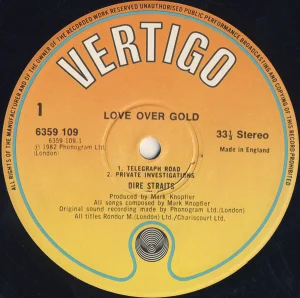The opening song on the A-side of Dire Straits’ ‘Love Over Gold’ album is Telegraph Road, a 14 minute long epic about the birth and death of a American frontier town. The first time I listened to it (in full) was on a original vinyl pressing from 1982. It jumped out of its sepia stained sleeve, I gave it an extensive beauty treatment and let the needle rest on the grooves. The lightning, piano, and Mark Knopfler’s unparalleled guitar solo unite in symphony. Yet, when I listened to same recording on Spotify, the song seemed comatose, its soul traded for corporate monetising.
This enlightenment about the value of vinyl is not unique, as evidenced by the hippies of Harrogate sifting through the HMV vinyl racks and the swarms of octogenarians in Oxfam buying copies of the ‘Oklahoma’ soundtrack to put on their Victrola. In this societal movement the quality of vinyl is proclaimed and if you are still in deliberation, I shall argue in the defence.
Fundamentally, the biggest factor in the appeal of vinyl to consumers is its physicality. In a world where there is a starvation of physical media, a product where your cash can be exchanged for an object in hand is nothing short of satisfying. Yet, even from the other end of the line, the benefit of its physicality is clear. As Mr Waldron (a musician himself) identifies, the money made through physical media like vinyl and CDs is greatly beneficial to aspiring musical artists in a way that online streaming isn’t.
As Adrian Pope, Chief Digital Officer of PIAS records, identified in our recent interview:
LP: What do you think the appeal of vinyl is?
AP:… It’s seen as art and part of the essence of having an affinity with an artist. In short, it became cool. Until the price rose, it was true that many people were buying two copies – one for their wall or shelf and one to sell on eBay. Half the people buying vinyl didn’t even have a record player! It was seen as ‘merch’ rather than a recording format.
Here Pope identifies an alternate customer basis for the purchasing of vinyl, that being aesthetic reasons. This though has clearly changed, more than likely due to the inflation in prices in new vinyl pressings. It can be said that this inflation in prices will slowly alienate it’s already growing customer base. For example, newcomers to this consumerist hobby often leave charity shops with rather glum faces after finding the same record they bought from HMV in an Oxfam, for a few weeks’ wages less. In this aspect, streaming is far more efficient as the great worldwide digital songbooks of Spotify and Amazon Music can play anything that has been written during recorded civilisation from Beethoven to the Bee Gees for a fraction of the price. So, has the vinyl revival actually peaked already? Is the industry out-pricing itself?
LP: How important is the revival of vinyl to the record industry & do you think it has reached its peak?
AP – in short, very. When CDs and downloads were dying and streaming had yet to fill the gap, the resurgence of vinyl saved the day for many. This is certainly true in the UK and many other markets, although the Nordics and Iberia/Latin America all went straight to streaming.
Demand peaked during Covid and 2022. We literally couldn’t make it fast enough. There were huge problems with supply (no manufacturing capacity meant long lead times (up to 9 months!), limited numbers of machines in the world, limited numbers of people who new how to use them; rising costs of metal parts/dyes etc; impact of Brexit and even tankers getting stuck in the Suez Canal!). All these things a) added huge delays b) limited sales and c) put prices up.
Prices have risen to the point where between that and the economic climate it’s dampened demand. More lines have come in stream this year so capacity also less of an issue.
So, has it peaked? Yes – certainly for the moment.
The environmental impact of Vinyl resurgence must also be assessed:
LP: Is the record industry doing anything to counter the environment impact of vinyl?
AP – Yes but it’s relatively limited. Somebody did a study a couple of years back and suggested the environmental cost of servers and streaming was higher than that of vinyl. Two wrongs don’t make a right, but you get my point. There’s definitely work done on more environmentally friendly dyes, packaging etc and pressing 140gsm rather than 180gsm. There’s widespread options out there – the challenge is time and economies of scale need to improve to bring the speed of manufacturing and price down.
In terms of the tribunal of environmental analysis and criticism, there are no winners, there are no losers. All businesses are still culpable for something. Some attempts have been made at replacing the rather toxic PVC with something called ‘Ocean Vinyl’ (recycled plastic), but it not large scale enough (yet) to meet the demand.
Overall, I believe an equilibrium between the digital and the physical is necessary. Digital media provides the efficient access to music options that, even 20 years ago, was nowhere close the vast catalogue of choices we have in our pockets. Vinyl, though provides a meditative break from the institutions of modern society,and is a medium that forces you to listen to the good (and maybe more importantly, the bad) that an album has to offer.

